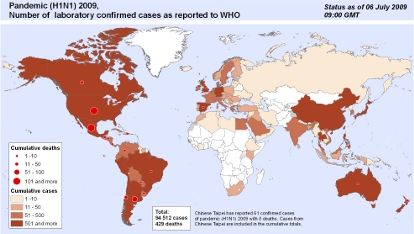According to the World Health Organization (WHO), there have been 94,512 cases of H1N1 flu virus worldwide, and 429 of those cases have resulted in death. Many people thought the swine flu had just gone away after everyone pretty much laughed at the way our US health officials ‘overreacted’ to the threat of this new flu virus. But make no mistake, the swine flu has not gone away. In fact, last month the WHO declared a Phase 6 Influenza Pandemic. Furthermore, the US is one of the most affected nations. Out of the 94,512 reported worldwide over the past few months, more than 33,000 of them have been in the United States, resulting in 170 deaths from the H1N1 flu virus in the U.S. Here are the current stats for the United States:
- 94,512 cases of H1N1 virus worldwide
- 429 deaths from H1N1 virus worldwide
- 33,902 cases in the United States (36% of all cases have been in the US)
- 170 deaths in the United States (40% of all deaths have been in the US)
Those stats are very alarming, considering the fact that we are not currently in flu season here in the US. That’s why this story is so crazy. Just imagine what those numbers could be when flu season hits.
Here is a map of the worldwide distribution of the H1N1 flu virus as reported by the World Health Organization:

According to an article at Reuters, the WHO has declared the H1N1 virus to be ‘unstoppable’. Furthermore, the World Health Organization has given drug manufacturers a green light to produce vaccines against the current pandemic H1N1 strain of the influenza virus. Dr. Marie-Paule Kieny, WHO director of the Initiative for Vaccine Research said, “The committee recognized that the H1N1 pandemic … is unstoppable and therefore that all countries need access to vaccine.” The WHO’s Strategic Advisory Group of Experts on Immunization, or SAGE, recommends that all nations provide a vaccine to their health workers – nurses, doctors and technicians. Then, each nation must create a priority list for vaccinations. Uh oh. I wonder where bloggers will be on the list.
Apparently, the elderly have an advantage over this flu virus:
The elderly seem to have some extra immunity to this new H1N1, which is a mixture of two swine viruses, one of which also contains genetic material from birds and humans. It is a very distant cousin of the H1N1 virus that caused the 1918 pandemic that killed 50 million to 100 million people.
Recently, the UK has seen a rise in H1N1 flu virus cases, and they are very alarming because a few healthy people have died from the virus. Most notably, a healthy 6-year-old girl contracted the virus. She got a sore throat, and then 2 days later she was dead. A healthy doctor also died from the virus in the UK:
The deaths of Chloe Buckley, six, and Dr. Michael Day mean three people with no previous health problems have now died of the illness out of a total of 17 deaths across Britain.
Sorry about the doom and gloom Tuesday. Whatever you do, don’t laugh at the H1N1 swine flu. It’s a very distant cousin of the influenza virus of 1918, which killed an estimated 50-100 million people while infecting upwards of 500 million people. Please take this virus seriously. If you can get a vaccination, please do.
Update (7-16-2009):
- World Health Organization: H1N1 pandemic spreading too fast to count (Reuters)
“The 2009 influenza pandemic has spread internationally with unprecedented speed. In past pandemics, influenza viruses have needed more than six months to spread as widely as the new H1N1 virus has spread in less than six weeks.”
